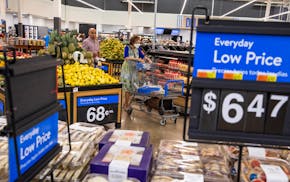Mike O'Brien used to ignore coupons.
That changed a few years ago when the Lakeville 61-year-old retired, he said, "just in time for inflation to rear its ugly head." Now he and his wife stick to budget-friendly grocery chains, buy in bulk and skip pricier items like apples and eggs. A backyard garden supplies vegetables in warmer months.
"It's kind of become who we are‚" O'Brien said.
Americans have learned to live with less in recent years as inflated post-COVID prices become the new normal. Though President Donald Trump pledged on the campaign trail to lower the cost of consumer goods like groceries starting on "day one," shoppers have yet to find relief. Prices are only expected to rise at a time when many consumers have little fat left to cut.
While inflation has fallen from a 40-year high in 2022, it's taken longer than expected for the Federal Reserve to reach its target of keeping it at 2%. The Personal Consumption Expenditures price index, the central bank's preferred inflation gauge, rose 2.5% year-over-year in February, according to data the U.S. Bureau of Economic Analysis released Friday. Core inflation, which excludes volatile food and fuel prices, rose 2.8%.
Those numbers don't reflect the escalating international trade war. Tariffs the U.S. is imposing on key trading partners are expected to slow spending, push up prices and drive core inflation above 3% this year, Michael Pearce, deputy chief U.S. economist at Oxford Economics, said in a statement Friday.
Gathering clouds
Cracks are already starting to form as prices continue to tick upward and consumer confidence wanes.
The February Producer Price Index, an early indicator for consumer inflation, showed a nearly 6% rise in food prices, the highest since 2023.
"There are some signs that the clouds are beginning to gather," said VV Chari, a University of Minnesota economics professor. The uncertainty is making consumers nervous, he said, which could affect their decisionmaking.
Kris Andrus, 58, said she started changing her grocery shopping habits when the pandemic started, but higher prices have hit harder this year.
The Eagan resident said she's more deliberate about what she buys than she was in the past, paying close attention to prices and choosing which stores to visit based on advertised deals.
She also does the shopping for her elderly mother, whose weekly grocery bill has jumped from $85 to as much as $140 for the same list of items in recent years.
When Andrus thinks about where the economy is headed, her worries range from the effect tariffs might have on access to fresh produce in winter to whether she'll be able to retire at 60 as planned.
"We're two years out and now everything's sort of going to hell, and I am very, very worried," she said.
She's not alone. Consumer confidence is at its lowest point since January 2021, with gloomy expectations about future finances, employment, inflation, the stock market and the possibility of a recession in the next year, according to a March 25 report from New York think tank the Conference Board.
On the edge
Low- and middle-income consumers — who are sensitive to high prices and the interest rate hikes the Fed has imposed to tame them — have already cut back.
A January report from budget grocery chain Aldi said it drew 19 million new customers over the past year, an increase of more than 18%, according to location analytics firm Placer.ai. Dollar General reported a record $40 billion in sales in fiscal year 2024, according to a March 13 earnings call.
"Many of our customers report they only have enough money for basic essentials, with some noting that they have had to sacrifice even on the necessities," CEO Todd Vasos said on the call.
When it comes to affording food, many are already on the edge.
After declining steadily between 2012 and 2019, the number of SNAP benefits recipients in Minnesota started rising again in 2020, according to data from the St. Louis Fed. More than 440,000 Minnesotans received assistance through the food-stamp program at the end of last year, according to Department of Human Services data.
Last year, Minnesotans made nearly 9 million visits to food shelves, which was 1.4 million more than 2023.
Erin Lemke, volunteer co-lead at 360 Communities Messiah Community Food Shelf in Lakeville, said demand has skyrocketed since the pandemic. The organization has expanded its hours from two days a week to six and serves about 100 clients a week, up from about 40.
The face of the need has also changed, Lemke said. She sees more families who didn't expect to need to visit a food shelf, but who are struggling even though both parents are working full time.
Though Messiah has had philanthropic success — including a donor who recently pledged to match $100,000 in donations — rising food prices could mean making cuts, Lemke said.
"It's definitely a concern," she said. "And I think, depending on how things go with these tariffs and with the economy as these changes are being made, it could definitely impact us."

Ramstad: Readers say Walmart won't be paying the ultimate price of Trump's tariffs

How Minnesota businesses can spot and prevent invoice fraud
No place for cryptocurrency in retirement portfolios

Minnesota Department of Health rescinds health worker layoffs

